

Solar Revolution - Spherical Solar Cells : DigInfo. Products - Sphelar Power Corporation. UD-led team sets solar cell record, joins DuPont on $100 million project. UD researchers Christiana Honsberg and Allen Barnett 5:14 p.m., July 23, 2007-- Using a novel technology that adds multiple innovations to a very high-performance crystalline silicon solar cell platform, a consortium led by the University of Delaware has achieved a record-breaking combined solar cell efficiency of 42.8 percent from sunlight at standard terrestrial conditions.
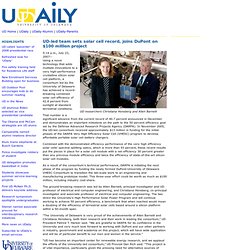
That number is a significant advance from the current record of 40.7 percent announced in December and demonstrates an important milestone on the path to the 50 percent efficiency goal set by the Defense Advanced Research Projects Agency (DARPA). In November 2005, the UD-led consortium received approximately $13 million in funding for the initial phases of the DARPA Very High Efficiency Solar Cell (VHESC) program to develop affordable portable solar cell battery chargers. "Many of us have been working with programs to take us to a real photovoltaic energy future. This project is already working in that future.
Can prisms be used to increase the efficiency of solar panels. Solar hydrogen home Michael Strizki. Solar Assisted Electrolysis. In a solar assisted electrolyser, commonly referred to as photo-electrochemical (PEC) generation of hydrogen, the required bias for water electrolysis is reduced.
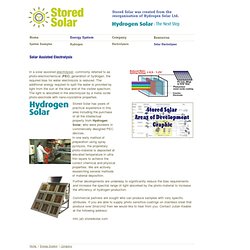
The additional energy required to split the water is provided by light from the sun at the blue end of the visible spectrum. The light is absorbed in the electrolyser by a metal oxide photo-electrode with nano-crystalline properties. In one early method of preparation using spray pyrolysis, the proprietary photo-material is deposited at elevated temperature in ultra thin layers to achieve the correct chemical and physical properties. We are actively researching several methods of material deposition. Further developments are underway to significantly reduce the bias requirements and increase the spectral range of light absorbed by the photo-material to increase the efficiency of hydrogen production. Commercial partners are sought who can produce samples with very specific attributes. Info (at) storedsolar.com. Energy. Maybe you want to save the planet, or maybe you just want to save money on your energy bills.

Either way, Control4 home automation helps you conserve energy and save money. With plenty of options to manage all of the power-consuming products in your home, you’ll have lots of choices that allow you to reduce your impact on the environment. Set your house to “Away” when you leave—even if you’re just out for the day. If your automation system knows there’s nobody home, it can take steps to conserve energy for you. Adjust the default setting for your lights from 100 to 90 percent.
Solar Hydrogen Process Produces Energy from Water. Special titanium oxide ceramics harvest sunlight and split water to produce hydrogen fuel.
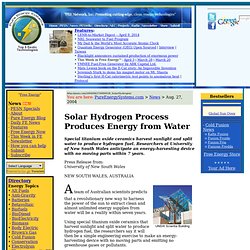
Researchers at University of New South Wales anticipate an energy-harvesting device with no moving parts within 7 years. A team of Australian scientists predicts that a revolutionary new way to harness the power of the sun to extract clean and almost unlimited energy supplies from water will be a reality within seven years.
Using special titanium oxide ceramics that harvest sunlight and split water to produce hydrogen fuel, the researchers say it will then be a simple engineering exercise to make an energy-harvesting device with no moving parts and emitting no greenhouse gases or pollutants. It would be the cheapest, cleanest and most abundant energy source ever developed: the main by-products would be oxygen and water. Rooftop panels placed on 1.6 million houses, for example, could supply Australia's entire energy needs. Solar hydrogen, Professor Sorrell argues, is not incompatible with coal.
Hydrogen economy. The hydrogen economy is a proposed system of delivering energy using hydrogen.
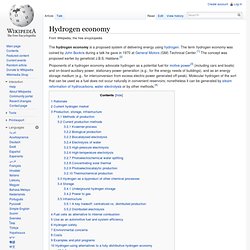
The term hydrogen economy was coined by John Bockris during a talk he gave in 1970 at General Motors (GM) Technical Center.[1] The concept was proposed earlier by geneticist J.B.S. Haldane.[2] Proponents of a hydrogen economy advocate hydrogen as a potential fuel for motive power[3] (including cars and boats) and on-board auxiliary power, stationary power generation (e.g., for the energy needs of buildings), and as an energy storage medium (e.g., for interconversion from excess electric power generated off-peak). Molecular hydrogen of the sort that can be used as a fuel does not occur naturally in convenient reservoirs; nonetheless it can be generated by steam reformation of hydrocarbons, water electrolysis or by other methods.[4] Rationale[edit]
SolMate iPhone 4 Case Is Not Your Typical Solar Charger. Okay, so solar power chargers aren’t anything new per say, so why should we care about this one?
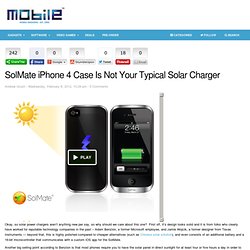
First off, it’s design looks solid and it is from folks who clearly have worked for reputable technology companies in the past – Adam Benzion, a former Microsoft employee, and Jamie Wojcik, a former designer from Texas Instruments — beyond that, this is highly polished compared to cheaper alternatives (such as Chinese solar solution), and even consists of an additional battery and a 16-bit microcontroller that communicates with a custom iOS app for the SolMate.
Another big selling point according to Benzion is that most phones require you to have the solar panel in direct sunlight for at least four or five hours a day in order to truly get a good charge. This isn’t the case for the SolMate, which actually works in the shade as well (just at a slower charging rate). Directly quoted from the above video, Jamie Wojcik had this to say about the SolMate: “SolMate is not another iPhone casing.